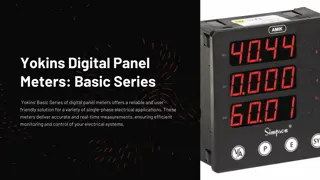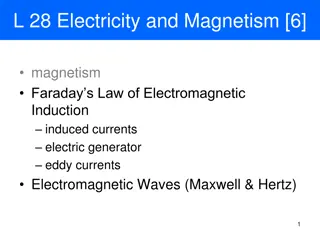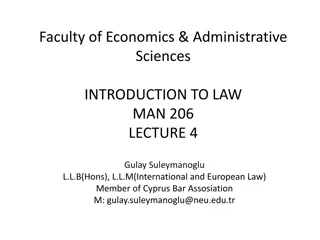Understanding Ampere's Circuital Law in Magnetostatics
In this lecture on Magnetostatics, we delve into Ampere's Circuital Law, which is a fundamental concept in electromagnetism. The law provides a general framework for calculating magnetic fields in various scenarios, especially in circular symmetric problems. Through examples and explanations, we explore the applications of Ampere's Law, magnetic flux density, and the right-hand rule. The concept of vector product and its relation to magnetic fields is also discussed.
Download Presentation

Please find below an Image/Link to download the presentation.
The content on the website is provided AS IS for your information and personal use only. It may not be sold, licensed, or shared on other websites without obtaining consent from the author. Download presentation by click this link. If you encounter any issues during the download, it is possible that the publisher has removed the file from their server.
E N D
Presentation Transcript
Lecture 10 Magnetostatics (2) 1. Ampere's Circuital Law 2. Magnetic Flux Density 3. Coding Example 1
1. Ampere's Circuital Law (ACL) Ampere's Circuital Law: Fundamental law in electromagnetic -A very general law - For circular symmetrical problems, H can be easily obtained using ACL. H = L (Ampere's law in integral form) d I C = H J (Ampere's law in differential form) C : any closed path encircling current I in the direction of non-thumb rigth-hand fingers I : total current encircled by C in the direction of the right-hand thumb - Dual equations is electrostatics: D = S (Gauss's law in integral form) d Q S = D (Gauss's law in differential form) v 2
Ampere's Circuital Law: Right-hand Rule -An easy method for remembering current direction and magnetic field direction 3
ACL in Point Form from Integral Form - Stokes' theorem: Fundamental formula in vector calculus. For proof, check with a textbook or with internet. = H L H S (Stokes' theorem) d d C S -ACL in integral form = = H L J S I d d C S - From above two equations, we obtain the ACL in differential form. = H J (Ampere's law in differential form) 4
Vector Prouct Vector or Cross Product: - Right-hand rule = n A B sin AB = B A A B = A A 0 = = = x x y y z z 0, 0, 0 = = = x y , z y z , x z x y x y z = A B A A A x y z = x y z B B B x y z = + + x y z ( ) ( ) ( ) A B A B A B A B A B A B y z z y z x x z x y y x 5
Ampere's Law Example: H due to Infinite Line Current - Current in +z direction - From Biot-Sarvart law, only H has only H component. z R IdL = = H d dH 2 4 R - Due to angular symmetry, H is constant on a circle C on the xy-plane with its center at , which is the path for Ampere's law. = H L d I C = = H L , H d d 2 2 = = = (2 ) H L d H d H d H 0 0 C I = H 2 6
Ampere's Law Example: H due to a Current Carrying Wire - Current in +z direction in a infinitely long current carrying wire of radius a - Current density is uniform on the wire cross section. I a , z a 2 = J 0, otherwise = (2 ) H L d H C I a 2 ( ), a 2 = I , otherwise I I , a 2 2 a = H I = , otherwise H 0 2 7
Ampere's Law Example: H due to a Coaxial Conducting Cylinder - Total current I uniformly flows on the inner conductor in +z direction. - Total current I uniformly flows on the outer conductor in z direction. -Application of ACL is straightforward and only the answer is given below. I , a 2 2 a I , a b 2 = H 2 2 I c c , b c 2 2 2 b 0, c 8
Ampere's Law Example: H due to an Infinite Planar Sheet Current - Due to infinite planar current geometry, only Hx exists. - Surface current density: Ky - Due to symmetry, we have , x 0 H z x = H , x 0 H z x -Applying ACL gives H = + = = L d H L H L I K L x x y C K y = H x 2 - One can generalize the result 1 2 = H K n 9
Ampere's Law Example: H due to Infinite Parallel Sheet Current - Surface current density is given by = , y 0 K z y = K = , y K z h y -Applying ACL gives , 0 x K z h x = H 0, 0 or z z h 10
Ampere's Law Example: H due to Infinitely Long Solenoid - Solenoid: Helical coil wound on a cylindrical surface - Ideal solenoid: No leakage outside the solenoid H = 0 for a < < H 0 at = (magnetic flux return path) -Assume H is uniform inside the solenoid. - Choose a closed path for ACL and obtain H inside the solenoid. - Wire current can be modeled as a surface current. 11
Ampere's Law Example: H due to A Toroidal Coil - Toroidal coil: Coil wound on a ring-shaped structure - Ideal toroid: No leakage outside the solenoid H = 0 outside the troidal core -Assume H is uniform in the toroidal core. - Choose a closed path for ACL and obtain H in the toroidal core. - Wire current can be modeled as a surface current. 12
Ampere's Law Exercise Problems Find H everywhere due to the following current distribution. 1. 2. , J a b = J = J , z z J a b 13
2. Magnetic Flux Density Magnetic flux -A concept for understanding the magnetic field - Magnetic field lines = lines of magnetic flux - Line density higher Higher magnetic field strength H - Symbol (uppercase phi), unit Wb (weber) - Weber in other units: Wb = Vs = J/A V = volt, s = second, J = joule, A = ampere ( ) Magnetic flux tube - Tube-like continuous surface where magnetic field lines are tangential. Figure: Left = Magnetic fluxe tube, Right = Magnetic flux tubes on the Sun's surface [Wikipedia] 14
Magnetic Flux Density B - Density of magnetic flux per unit area - Symbol B (uppercase phi) - Unit Wb/m2 = T (tesla), 1 T = 104G (gauss) - B in terms of H = B H (definition) 0 7 = 4 10 H/m (permittivity of vacuum) 0 - Permittivity = - Magnetic materials have higher permittivity than vacuum. - Calulate using B: Total magnetic flux going through S in dS direction B = S d S D = S Q d - in magnetics corresponds to Q in electrostatics: S 15
Divergence of B - Magnetic field lines always form closed loop. - On a closed surface, outgoing flux = incoming flux Gauss's law for magnetic field B d = S 0 S = B S B (divergence theorem) d dV S V - The above equation holds for any volume V enclosed by S. - Using the divergence theorem, we obtain a point form of Gauss's law for magnetic field. = B 0 - In electrostatics, electric flux emanates from and terminates on charges. D = S d Q S = D v 16
Magnetic vs Electric Field Lines Figure: (a) Bar magnet, (b) finite solenoidal coil, and (c) electric dipole - Magnetic field lines: Closed loops - Electric field lines: Open loops 17
Orders of Magnetic Field B [Wikipedia] 10 18T: Lowest B that can be measured. Use SQUID magnetometers. 10 12T: Human brain acitivity 10 7to 10 6T: Environmental magnetic field (appliances, power transmission lines) 10 5 T: Earth's magnetic field 1 mT: Refrigerator magnet 0.1 T: Sunspot 1 T: Neodymium rare earth magnet 1 to 10 T: Power transformer core, MRI, NMR spectrometer 45 T: Strongest continuous magnetic field in laboratory (National MagLab) 103T: Strongest pulsed magnetic field in laboratory (VNIIEF) 106T: Non-magnetic neutron star 108to 1011T: Magnetar 1014T: Heay Ion Collider (RHIC) 18
3. Coding Examples Example 1: Test the Ampere's Law with a Circular Loop An infinite z-directed current with I = 1A located at ( , ) in cylindrical coordinate (m). in meter and in degrees. Ampere's law integration loop: a circle wiith center at (x, y) = (0, 0) and radius a (m) Calculate = H L F d C a) when < a and compare it with theory, b) when > a and compare it with theory. Input: , : position of the line source (m, deg.) a: radius of a circle for the Ampere's law integration (m) Output: F(theory): theoretical value of F F(num): numerical value of F 19























